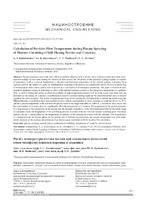Calculation of Particle Flow Temperature during Plasma Spraying of Mixture Consisting of Self-Fluxing Powder and Ceramics

Date
2018Publisher
Another Title
Расчет температуры потока частиц при плазменном напылении смеси самофлюсующегося порошка и керамики
Bibliographic entry
Calculation of Particle Flow Temperature during Plasma Spraying of Mixture Consisting of Self-Fluxing Powder and Ceramics = Расчет температуры потока частиц при плазменном напылении смеси самофлюсующегося порошка и керамики / A. S. Kalinichenko [et al.] // Наука и техника. – 2018. – №3. - С. 177-182.
Abstract
Plasma spraying is one of the most effective methods allowing both to restore worn surfaces of parts and create wearresistant coatings on new parts aiming the increase of their service life. Properties of the produced coatings depend on number of parameters, such as a plasma temperature, a chemical and fractional composition of the sprayed mixture, a distance from a plasma torch to the surface of a part, etc. Mathematical modeling of the process can significantly reduce the cost of processing of technological modes and is widely used at present for a calculation of technological parameters. The paper is devoted to mathematical simulation aiming to determine an effect of the injected ceramics content on the change in a temperature of a particles flow, as well as finding the modes in which the particles of high-temperature ceramics will be in the liquid state when they are deposited on the surface of a product. A mathematical model of particles heating in plasma has been formulated and a system of equations has been compiled. The system of equations has been solved numerically in Mathcad by a standard procedure using the Rkadapt function. Calculations have been carried out for a volume concentration of Al₂O₃ ceramics in a mixture from 5 to 50 % and for a plasma temperature at the exit from the plasma torch in the range from 6000 to 10000 K. Calculations have shown that the concentration of ceramics does not significantly affect the temperature of a mixture. The temperature of the particles depends to a large extent on the temperature of the plasma and the diameter of particles. It has been determined that for the entire range of calculated values the temperature of the self-fluxing powder in contact with the substrate exceeds a melting point. Fractional particle size has a strong effect on the temperature of particles at the moment of contact with the substrate. The dependences of a temperature of the ceramic phase on the particle size at different concentrations and plasma temperature have been determined. Analysis of the coatings microstructures has shown a good correlation with the results of the calculation.
Abstract in another language
Плазменное напыление является одним из эффективных методов, позволяющих как восстанавливать изношенные поверхности деталей, так и создавать износостойкие покрытия на новых деталях с целью увеличения срока их службы. Свойства создаваемых покрытий зависят от ряда параметров, таких как температура плазмы, химический и фракционный составы напыляемой смеси, расстояние от плазмотрона до поверхности и др. Математическое моделирование процесса позволяет значительно снизить стоимость отработки технологических режимов и широко используется в настоящее время для расчета технологических параметров. В настоящей работе была поставлена цель проведения математического моделирования для определения влияния содержания вводимой керамики на изменение температуры потока частиц, а также нахождения режима, при котором частицы высокотемпературной керамики будут в жидком состоянии при осаждении на поверхность изделия. Сформулирована математическая модель нагрева частиц в плазме и составлена система уравнений, которая решалась численно в пакете MathCad стандартной процедурой с использованием функции Rkadapt. Расчеты проводились для объемной концентрации керамики Al₂O₃ в смеси от 5 до 50 % и для температуры плазмы на выходе из плазмотрона в интервале от 6000 до 10000 К. Вычисления показали, что концентрация керамики не влияет значительно на температуру смеси. Температура частиц в большей мере зависит от температуры плазмы. Определено, что для всего диапазона расчетных величин температура самофлюсующегося порошка при контакте с подложкой превышает температуру плавления. Фракционный размер частиц оказывает сильное влияние на температуру частиц в момент соприкосновения с подложкой. Определены зависимости температуры керамической фазы от размера частиц при различных концентрациях и температуре плазмы. Анализ микроструктур покрытий показал хорошую корреляцию с результатами расчета.
View/
Collections
- №3[11]
